How To Keep Your Tomato Plants Healthy And Long Producing
Tomatoes are one of our favorite veggies to grow AND one of our most popular seedling and veggie order items.
There is nothing quite like harvesting a tomato fresh off the vine and taking a bite.
Warm, sweet, and savory, and nothing beats it. Mmmm...I just can't wait until the fruits are here again! I bet you can't either.
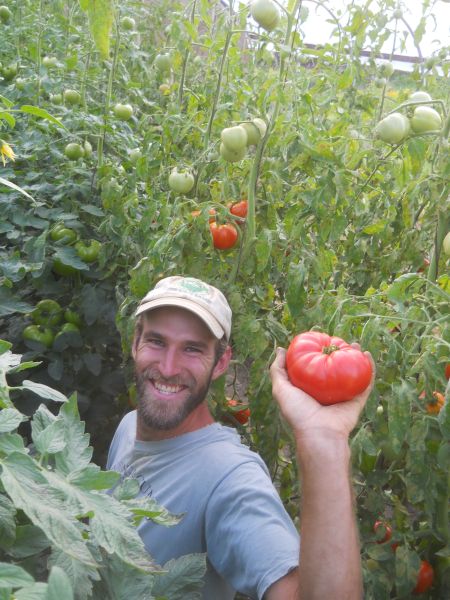
But how to take care of your plants for best success?
Enough waxing on about how good tomatoes are. Let's get down to reality.
Maybe you've had your plants melt into the ground in a wet year leaving you with not very many fruits?
Or you've had your tomato plants form a huge sprawling mess in your garden that's hard to harvest and takes up a lot of space?
Or your plants grow taller than your tomato cage and spill back over breaking off?
If you're wondering how to care for, support and prune your tomato plants for lots of fruits and healthier plants, we're here to help!
Pssst: Now's the time to get started!
When to begin tying up tomato plants?
Now! That's right. I don't know about you, but our tomato plants just sat there for a lot of the month of June waiting out the cool temperatures and steady rainfall.
They're finally settling in and are getting ready for support. This hot weather will help them grow fast and catch up!
The ideal time to start providing support to your tomato plants is shortly after they start flowering but before they get too bushy.
Many people ask us how we support or tie up our tomato plants. Especially those who come to the annual Open Farm Day event are particularly impressed with the greenhouse tomatoes that are pruned and trellised growing vertically. (Interested in seeing the farm this year? Come to our Open Farm Day event)
There are many great answers to the question of tomato support and I'm here to help you figure out what is best for you.
And also maybe to inspire you to try something new in your garden!
Why bother to tie up your tomato plants in the garden? (AKA Why not let them sprawl?)
First you don't have to support your plants or prune them or trellis them or do anything fancy to get tomatoes.
If you are a garden minimalist, do not fret.
You will get tomatoes and lots of them even if you just let them lie on the ground.
Actually we do that out in the field! That's because we've had our trellis system blow over one too many times for us to keep going out there and setting it back up for hundreds of feet.
So with that over with, what are the reasons you might want to support your tomato plants?
- To reduce disease: Tying up tomato plants in some manner keeps them off the ground and avoids the wetness and lack of air circulation associated with diseases on the leaves and fruits.
- To get better size and quality: When you tie up your tomatoes (especially using the trellising method below) you are better able to prune them to increase airflow which increases quality and decrease number of fruits which can increase the size of each fruit.
- To make picking easier: No brainer, right!? Unsupported tomato plants have their fruits lying on the ground. Supporting your plants allows for picking at a higher height, much easier than bending all the way down to the ground.
- To save space in the garden: Tomatoes can be huge space hogs if you let them. They make a sprawling mess on the ground to be honest. In fact, we allot 9 feet of width for our plants in the field to sprawl. Tying them makes use of the vertical space in your garden, saving more room for other things. Or at least a walking path!
And now on to options...
But, first, what kind of tomato plants are you growing?
There are two basic kinds of tomatoes, as outlined below, and it's good to know what yours is when considering your choice for support (or not).
- Determinate – Plants will bear all their fruit around the same time. These plants are typically smaller, grow to a certain size, and then stop. These are great options for using a tomato cage or even leaving to lie on the ground. They will not outgrow the tomato cage and will not produce over a long period of harvest time.
- Indeterminate – Plants continue to bear fruit until frost, given proper environment. Depending on the length of the season, these tomatoes can grow into very large plants that usually appreciate support of some kind.
How to keep your tomato plants healthy and long producing
There are many ways to approach caring for your tomato plants. From elaborate to not at all, all methods are valid, have their pros and cons, and will result in tomatoes to eat!
Here are the basic options for tomato support with instructions on how to do it to help you on your way to a great garden!
I break it up into two categories: to prune or not to prune.
First category: No pruning needed
#1: Do nothing at all
As I mentioned before, you can just do nothing and you will get fruit. So breathe easy! We actually do this method in the field because staking up rows that are 180 feet long have proved very difficult to keep from falling down due to the wind that can whip through our farm.
So do we get tomatoes? YES! Is the yield magically perfect? NO! We have to make the trade off and the tomatoes from the field can be less productive left to their own devices especially in wet years. But the labor saved is worth it to us (we just plant more plants).
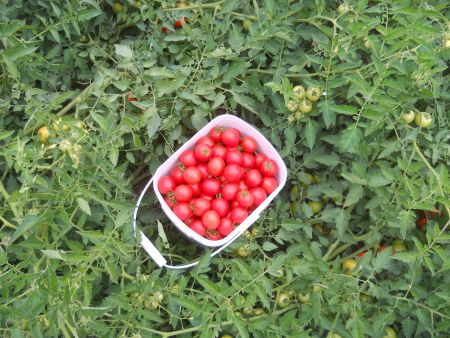
#2: Use tomato cages either store bought or homemade
Tomato cages are metal supports with spikes that insert into the dirt around your plant and have concentric circles that increase in size moving up the cage. They are typically four to five feet tall. The tomato will lean against the cage, offering it support. Tomato cages are a great option for determinate varieties that do not get very large, or if you do not plan to do much pruning (lack of pruning will lead plant to grow out and less tall vertically). Occasionally guiding the branches through the cage to ensure support and pruning to increase airflow will yield healthy plants with this method.
This is a great method for very small gardens and raised beds. These are readily available at garden stores locally and online. They're great if you have a few plants. Here's a picture of Assistant Farmer Hannah's plants in her garden at her apartment. Beautiful, huh?
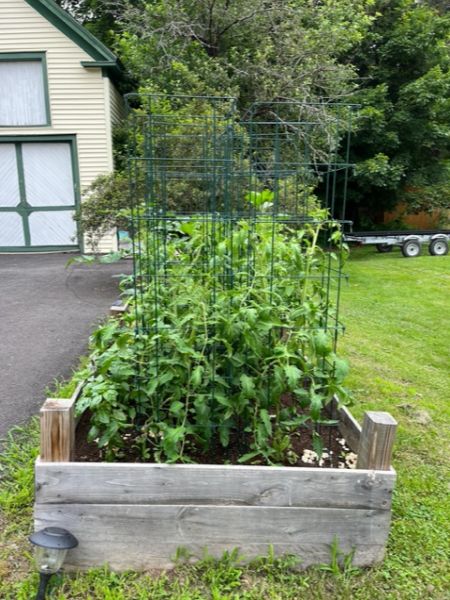
#3: Basket weaving
This is an inexpensive method that works for rows of tomatoes in a garden setting. This is what we use in our daughter's small garden in the front of our house as well as what we used to use in the fields before we realized it was futile because the wind kept knocking it down. But used in a smaller setting, it works great!

How to basket weave:
- Drive grade stakes or Tposts or other supports every 3-5 feet along your row of tomatoes in line with the plants.
- Tie twine around one end at about 8-12” off the ground.
- Then loop around each stake as you come to it along one side.
- Repeat on other side until you've cradled up the plants from either side.
- Start another course of twine another 6-8” up from your first one. Repeat steps 2-4.
- Come back periodically (every week works well) and do another couple courses of twine until plants are done growing.
Second category: Pruning needed
How to prune tomato plants (advanced):
Pruning tomatoes takes practice, I'm not going to lie. But once you can "see" what are called suckers (what you need to pull off) it's an easy task. Here are the steps with pictures to help:
- Identify your one or two main leaders: Do not skip this step! Before you start pruning off suckers make sure you know what you are keeping. In the larger picture in the collage below you'll see the #1 main leader, which is the tallest part of the plant. If you are trellising to a single leader that is the only active growth point that you'll keep. If training to two leaders you'll want to keep the next most vigorous growth point, which always forms in the leaf juncture below the first flower cluster to develop on the plant as visible in the same picture.
- Identify the sucker: It is a smaller "leader" which in (not very much) time will create a large stem that you don't want on your plant. Pictured below in top small picture.
- Pick it off with your fingers: Try your best to get as much of the entire stem as possible to prevent another sucker growing from that same spot in the future. Middle small picture below.
- Discard the sucker: You can just drop it on the ground like we do. Bottom small picture below.
- Repeat: Find all the suckers that there are, remove them, and discard until you have your plant pruned to however many stems you want. One stem is usually used for staking and trellising or you can use two stems for a trellis system like we do. We try to prune once a week during rapid plant growth.
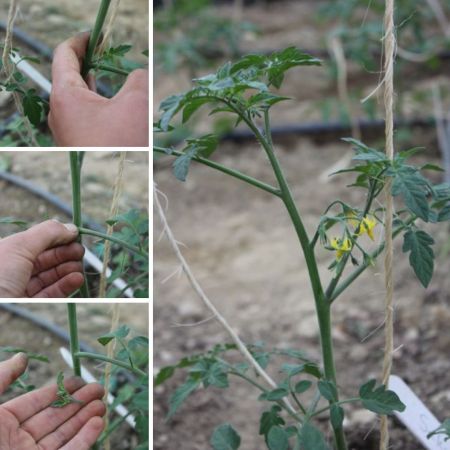
#4: Staking
To stake tomato plants, simply place a large (about six foot) wooden stick or dowel in the ground close to the stem of the plant. Tie the stem loosely to the stake with twine as needed for support. This method works best if you keep your plant to one main stem, rather than letting it form additional main stems.
#5: Trellising
This is the Cadillac method for tying up tomatoes! We use this in our greenhouse because it is space saving and we are able to tie up to the existing roof system of our greenhouse frame. But, this can also be done in a home garden setting by providing some kind of horizontal support above the plants. Just needs to be strong enough to hold them!
How to trellis tomatoes:
- Set up your support system.
- Tie two strings (we use sisal twine) per plant to your top support. Make them long enough to barely touch the ground.
- Take the two strings and tie them together under the first set of flowers on your tomato plant. Make it taught enough to keep the plant standing up, but loose enough to wiggle the string back and forth about 6-12”.
- Prune the plant to two growth points ('leaders') that will grow up.
- Wrap the string around the stem of the plant in a loose spiral to support the plant and keep it from falling to the ground. Not so tight as to impede growth. We do this each week when we prune, generally adding about one loop of the spiral each week.
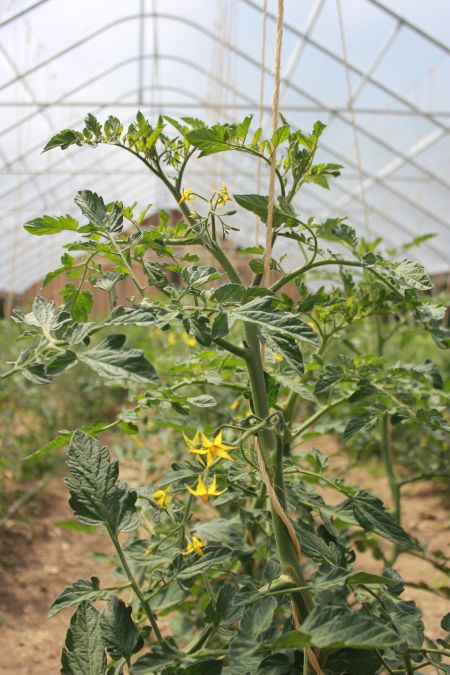
How do you tie up your tomatoes? Or do you? Please comment below and let us know. We all benefit from learning from each other!



Add new comment